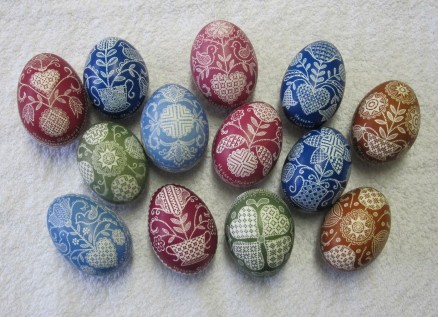As in other parts of the world, decorating eggs for Easter has also been a long tradition in Hessia. In this region there are three different techniques used to decorate eggs:
- The wax-resist or batik method
- The scratch technique
- Embroidery with Schwalm Whitework motifs
I present the first two techniques here, the third–with detailed instructions–will be posted soon.
The wax-resist or batik method
In the region surrounding Marburg raw chicken eggs (today, blown out chicken eggs are also used) are first decorated–with images and written sentiments–using wax in accordance with ancient custom. Then these eggs are dyed and afterwards the wax is removed.
One can find out more about this technique and the patterns used here:
www.margot-bieker.de
The scratch technique
Large blown out chicken eggs with white eggshell are dyed first and then the pattern is scratched out. This technique is well known in many regions, unique here are the patterns; motifs of Schwalm Whitework are scratched into the front of the egg, short verses in old German letters http://www.suetterlinschrift.de/index.html are engraved into the back, and an encircling band with “Openwork patterns“ divides the front of the egg from the back.
Because such eggs are rare, I have published a 23-page leaflet showing 23 different decorated Easter eggs. Included on each page is: a line drawing of the front motif, which–depending on the design–could be used for Schwalm Whitework; the translation of the verse; a colored picture of the pattern band; an image of the same pattern band embroidered.
This lovely and informative leaflet has a plastic comb binding, and you may order it through my Shop.









Luzine, these Easter eggs are amazing! So beautiful!! Kerryn
Hallo Luzine,
momentan sind Eier eben hot im Stickerei-Land :). Mary Corbet stickt gerade auf Eier: http://www.needlenthread.com. Vielen dank für’s zeichen!
Übrigens werde ich Morgen und Übermorgen bei Lada van Wijnbergen Vologda-Stickerei erlernen: http://www.atelierhethaantje.nl/borduurwerk-uit-vologda.html.
Ein schönen Tag wünscht,
Jessica
Wonderful eggs!
Beautiful! Brings back memories of childhood in Central Europe 🙂
So beautiful and as always inspiring. Thank you.
Luzine, all these eggs are so beautiful. Thank you so much for sharing. My husband and I must come and visit Germany one day. Jenny
Luzine, die Ostereier sind wunderschoen.
Ana-Maria
How beautiful these eggs are. I am familiar with the wax resist technique, but the scratching technique seems a little scary….one wrong move and you would have a cracked Humpty Dumpty egg!
xo,
Deb
What a lovely website! I’d love to learn schwalm embroidery and make a German Easter egg to add to my Easter tree of embroidered and smocked Easter eggs. I’m looking forward to your instructions on how to make a schwalm egg.
Dolores B, Michigan USA
Dear Dolores,
I hope, you found the right post about embroidered Easter eggs in the meantime. Please look to the blog archive March 2013
If there is any question, please email me.
Best regards
Luzine
Godd afternoon Luzine,
I have been looking through your website I have found a new place for information. I am in love with the easter eggs. however i do no speak german. so not sure what the information is saying. do you have this someplace translated into english.
Lora
Hi Lora,
in top right of my page you can find a translation button. Please press the British flag.
Hope, this helps
Luzine
When I was a little girl there were often women who would demonstrate how to make the Ukranian wax eggs – and my nose was always pressed as close as possible.
Eggs are such a symbol of Life and I have loved them ever since my childhood.
Thank you for sharing so much of yourself.
Hi Lucine, Can I embroider these eggs on a tablecloth?
Hi Elsa,
Yes, you can embroider them on a tablecloth. May be, for a tablecloth you should enlarge the motifs a little bit, so it is easier to fill them with patterns. You can put some different motifs side by side in a straight line. You can also surround the motifs with an oval of stitches – may be Coral Knot stitches or Chain stitches – to show them as eggs.
More and other Easter eggs you will find in my blog on 19, April.
Best regards
Luzine
Hallo liebe Luzine,
meine Mutter hat diese Eier über Jahre gesammelt, auf jedem ihrer Eier stand immer die jeweilige Jahreszahl in dem sie das Ei kaufte, nach Ihrem Tod habe ich die Sammlung gehütet, aber leider sind 2 Eier aus 1999 und 1998 kaputt gegangen. Gibt es eine Möglichkeit hier Ersatz zu bekommen? Viele Grüße Kerstin Müller
Googlen Sie doch mal “Mardorf Ostereier”, da finden Sie sehr viel.
Eine Adresse habe ich Ihnen herausgefischt:
Hildegard Kempf und ihre oberhessischen Wachsbatikeier. (Amselweg 1, Mardorf, Tel 06429 921531)